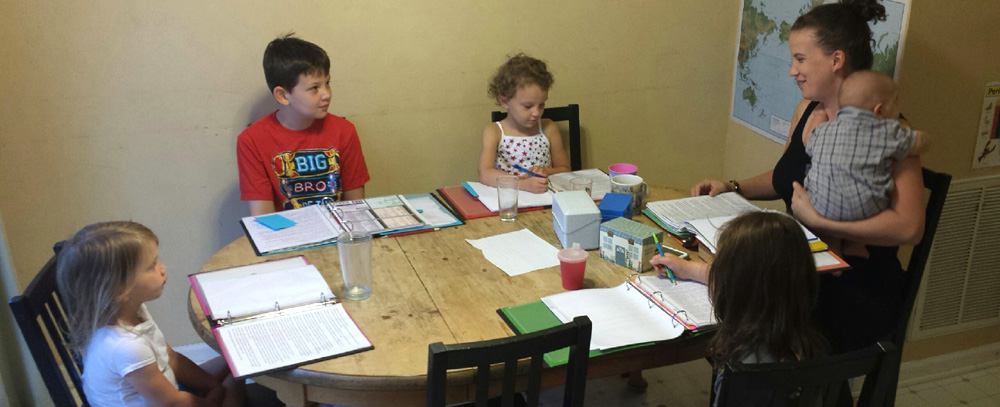It is probably not hyperbole to say that there is one thing that has transformed our homeschool in the past year. A simple 30-45 minutes each day revolutionizes our perspective. It provides the framework for my ultimate goal in education: raising people who believe what is true, honor what is noble, stand uncompromisingly for what is just, keep their desires pure, love things that are lovely and relish those things that are praiseworthy (Philippians 4:8). As we resume our intellectual endeavors this fall, it is a thing that lends great joy to this crazy homeschool life.
In years past I had a great goal list. I wanted to incorporate things of beauty and intrigue into our daily life, memorizing poetry, Bible verses and creeds, famous speeches, Shakespeare and key facts of history, math, etc. The goal list looked great, but I never figured out how to make it fit into an actual day. By the time we finished math and grammar and our other essentials, I was exhausted; the laundry piles were screaming; the kids were done with anything that didn’t come on a screen, and something needed to be thawed for dinner. Those interestingly beautiful things gathered dust on my to-do list and led to increasing despair that my vision for a lovely education was being trounced by reality.
Last summer, I was inspired by the work of educators like Sarah Mackenzie (author of my current favorite homeschool book published by Classical Academic Press: Teaching from Rest), Mystie Winckler and others to incorporate something variously called Morningtime or Circle Time. I’m a little bit of a rebel who prefers to improvise on a theme rather than follow a strict recipe both in my cooking and in my life. Thus, we have used their ideas as a jumping off point rather than an exact model. I will share what it has looked like in our own homeschool life, but I definitely do not want to take the credit for something that is done much more thoroughly, professionally and certainly originally by others who are wiser and more experienced than I.
During morningtime in our home, we have incorporated many things that otherwise seem to get left out. Generally it falls in our schedule immediately after breakfast and chores, but I know other families have found that lunchtime or even afternoon works best for them. Even the young children participate, as morningtime becomes another piece of our family culture. Last year, I eased in with an abbreviated routine, valuing consistency over aiming too high and possibly failing. This time quickly became a favorite part of the day for both the kids and me.
This year, we are becoming a bit more ambitious, adding a few more areas of interest and lots of fun things to memorize. For most of this memory work, we use a box system inspired by Simply Charlotte Mason* that helpfully incorporates both daily review for new memory work as well as cyclical review based on day of the week and day of the month. My favorite part of this looping review is that we can never get behind; we just do the work assigned for Thursday even if we neglected to do the work on Wednesday!
 This is what morning time currently looks like for our family:
This is what morning time currently looks like for our family:
After opening our time in prayer, I begin by reading a Bible story aloud. Next we focus on our new Bible memory passage, questions and answers summarizing Christian doctrine and review verses based on the day of the week and day of the month. We conclude this portion of our morning by singing the Doxology. Even the non-readers love to add their vigorous voices at this point!
Now everyone stands up and giggles through a geography song with ridiculously fun motions helping us memorize the major lines of latitude before doing some map tracework. I printed the maps and placed them inside plastic protector pages so the kids can use wipe-off markers for tracing each day.
Then comes a favorite portion of our morningtime: memorizing poetry and other famous passages! Rather than spending lots of time on any one item, we read (or sing) them enthusiastically in unison one after the other. It is amazing how even after just a few weeks the kids are already gaining so much confidence and recall from mere daily recitations. This fall, we are focusing on the preamble to the US Constitution, portions of the Declaration of Independence, a list of the presidents and their dates of office (mangled to fit the tune of “If You’re Happy and You Know It”), “The Charge of the Light Brigade” by Tennyson, and “Nothing Gold Can Stay” by Frost. Using our memory box system we review previously memorized poems and creeds. We also have songs assisting us in learning a history timeline and skip counting for math.
Finally, we go around the table from youngest to oldest for individual prayers. It is an especially favorite time of mine to hear lisping voices pray for often obtuse but always earnest matters. In conclusion, I lead us in praying the Lord’s Prayer.
Is morningtime right for your homeschool? While it most certainly will look different for every family, the basic concept will assist you in developing a family tradition based on the true and lovely and praiseworthy. If we are, as Philippians admonishes us, to “think on these things,” morningtime can help us incorporate that which lines up with our individual family’s values and interests. Our current American history studies mean we are learning the list of presidents, but perhaps your family wants to memorize the periodic table of elements, enjoy some art study, or relish a particular composer this year. Do not try to make your morningtime look just like anyone else’s. Start small and simple and just do it every day. When the habit is formed, try adding in something that will bring delight to your own heart. By sharing something that fills you, the teacher, with joy, you are giving your students a vision for a future filled with new delightful things to learn even when school years are over.
Morningtime is as simple or as complex as you want it to be, but its greatest gift is the perspective it lends. Because as often as we tell our children that education is more than checking off the boxes and plowing through the books, too often that ends up being all we actually accomplish, and they are left with a philosophy of learning based much more on what we do than on what we say. By using morningtime to fill their minds and imaginations with things that delight and inspire, we fan the flames of a lifelong love of learning.




